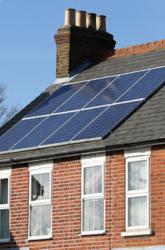Solar panels have been one of the most successful renewable energy sources for individual households in the UK, with government estimates suggesting that nearly 4 million UK households will have solar panels fitted by 2020. This optimistic statement came as the government were preparing to cut back subsidies for homes using solar energy and shows that the government at least, don’t think that homeowners will be deterred by the cut in Feed-In Tariffs (FiT).

SolarPanels.co.uk has conducted recent research into the highs and lows of the solar panel industry.
Feed-in Tariff Rates
Back in 2010 the tariff rates were set at 43p per kilowatt hour to encourage customers to generate their own low carbon electricity on a small scale. The rate also reflected the high cost of solar installations. Customers would make this investment in solar energy and in return they received a payment from their electricity provider as well as a payment for any surplus energy which was exported back to the National Grid.
However installation costs have fallen dramatically and so the government cut back the rate to 21p kWh. This rate is applicable for customers who have an eligible installation date on or before the 31st July 2012. After the 1st August the FIT will drop again to 16p kWh. So surely this is bad news for customers? Well not necessarily.
Solar Panel Benefits for Consumers
The government predicts that households should make at least 5% profit on their solar panel investments. That means that not only will homeowners benefit from free energy most of the year, but they will also make a small profit on the tariff rates and export rates.
What’s more is that the export tariff has actually increased for all new solar panel installations to 4.5p kWh. These are guaranteed payments which will last for 20 years on new solar PVs installed. Those householders who had their solar panels fitted before the decrease have a guaranteed payment agreement which will last 25 years from the date of their installations.
In order to benefit therefore, from the full 21p per kWh one must ensure that one applies quickly and has an installation date before the 31st of July, 2012. One must also ensure that they meet the government’s criteria by obtaining an EPC, or Energy Performance Certificate.
Energy Performance Certificates
Most white goods now come with an EPC to show how energy efficient they are and this is just the same for solar panels. EPCs must show a grade D (55% energy efficient) or above for households to claim their 21p kWh. Most new solar panel installations will help increase energy efficiency and of course, as the EPC is valid for 10 years, should one decide to sell thir home, a high EPC grade will make their property more desirable.
So the benefits of solar panel installations are still just as relevant for homeowners today and still worth the investment.
About SolarPanels.co.uk
SolarPanels.co.uk UK's leading solar energy website allows customers to obtain 3 free no obligation quotes for solar pv and solar thermal. Find out more at http://www.solarpanels.co.uk
This press release is presented for your information only.
Full Disclosure Statement: The GREEN (LIVING) REVIEW received no compensation for any component of this article.
This article is for your information only and the GREEN (LIVING) REVIEW does not (necessarily) approve, endorse or recommend the product, service or company mentioned.























